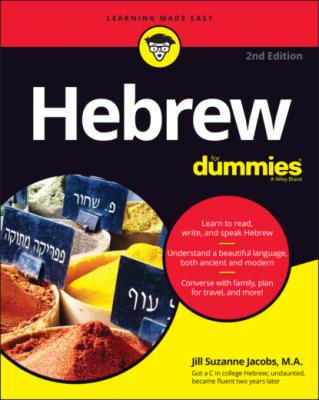Hebrew For Dummies. Jill Suzanne Jacobs
Чтение книги онлайн.
Читать онлайн книгу Hebrew For Dummies - Jill Suzanne Jacobs страница 13
 to say “two books,” you say שְׁנֵי סְפָרִים (shnay sfah-reem); for “three books,” say שְׁלוֹשָׁה סְפָרִים (shloh-shah sfah-reem); for “four books,” say אַרְבָּעָה סְפָרִים (ahr-bah-ah sfah-reem); and so on.
to say “two books,” you say שְׁנֵי סְפָרִים (shnay sfah-reem); for “three books,” say שְׁלוֹשָׁה סְפָרִים (shloh-shah sfah-reem); for “four books,” say אַרְבָּעָה סְפָרִים (ahr-bah-ah sfah-reem); and so on.
Counting higher
To form the numbers 11–19, place the second number in front of the 10. In the masculine form, for example, 11 is אַחַד עָשָׂר. In the feminine form, 11 is אַחַת עֶשְׂרֵה (ah-chaht es-reh). Table 1-2 shows the numbers 11–19.
The multiples of ten (10, 20, 30, and so on) are easy because these numbers are gender-neutral. Table 1-3 shows the multiples of 10.
TABLE 1-2 Counting from 11 to 19
| Number | Masculine | Feminine |
|---|---|---|
| 11 | אַחַד עָשָׂר (eh-ḥad ah-sahr) | אַחַת עֶשְׂרֵה (ah-ḥaht ehs-reh) |
| 12 | שְׁנֵים עָשָׂר (shnehym ah-sahr) | שְׁתַּיִם עֶשְׂרֵה (shtehym ehs-reh) |
| 13 | שָׁלוֹשׁ עָשָׂר (shloh-sha ah-sahr) | שְׁלוֹשָׁה עֶשְׂרֵה (shlosh-ehsreh) |
| 14 | ַ אַרְבָּעָה עָשָׂר (ahr-bah-ah ah-sahr) | אַרְבַּע עֶשְׂרֵה (ahr-bah es-reh) |
| 15 | חֲמִשָּׁה עֶשֶׂר (ḥah-mee-shah ah-sahr) | חָמֵשׁ עֶשְׂרֵה (ḥah-mesh es-reh) |
| 16 | שִׁשָּׁה עֶשֶׂר (shee-shah ah-sahr) | שֶׁיֵּשׁ עֲשָׂרָה (shehsh ehs-reh) |
| 17 | שִׁבְעָה עָשָׂר (sheev-ah ah-sahr) | שְׁבַע עֲשָׂרָה (shvah es-reh) |
| 18 | שְׁמוֹנָה עֶשֶׂר (shmoh-nah ah-sahr) | שְׁמוֹנֶה עֶשְׂרֵה (shmoh-neh ehs-reh) |
| 19 | ש תִּשְׁעָה עָשָׂר (teesh-ah ah-sahr) | תְּשַּׁע עֶשְׂרֵה (tshah-esreh) |
TABLE 1-3 Counting Multiples of 10
| Number | Hebrew | Pronunciation |
|---|---|---|
| 20 | עֶשְׂרִים | ehs-reem |
| 30 | שְׁלוֹשִׁים | shloh-sheem |
| 40 | אַרְבָּעִים | ahr-bah-eem |
| 50 | חֲמִשִּׁים | ḥah-mee-sheem |
| 60 | שִׁשִּׁים | shee-sheem |
| 70 | שִׁבְעִים | sheev-eem |
| 80 | שְׁמוֹנִים | shmoh-neem |
| 90 | תִּשְׁעִים | teesh-eem |
If you want to say something like “21” or “47,” however, you have to pay attention to gender again. (See Table 1-4.) The pattern for making these numbers is to state the number in the tens, such as עֶשְׂרִים (ehs-reem; 20) and then add the word for and (וְ’; veh), followed by the single number, such as אֶחָד (eh-chad; one). So, 21 would be עֶשְׂרִים וְאֶחָד (ehs-reem veh-eh-chad).
TABLE 1-4 Counting from 21 to 29
| Number | Masculine | Feminine |
|---|---|---|
| 21 |
עֶשְׂרִים וְאֶחָד (ehs-reem veh-eh-ḥahd)
|